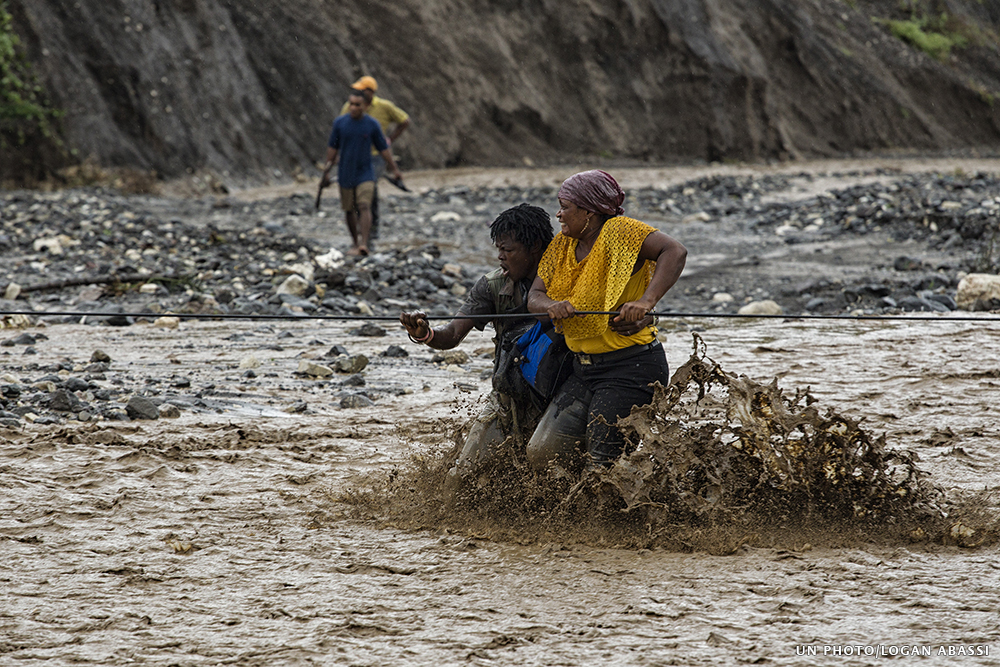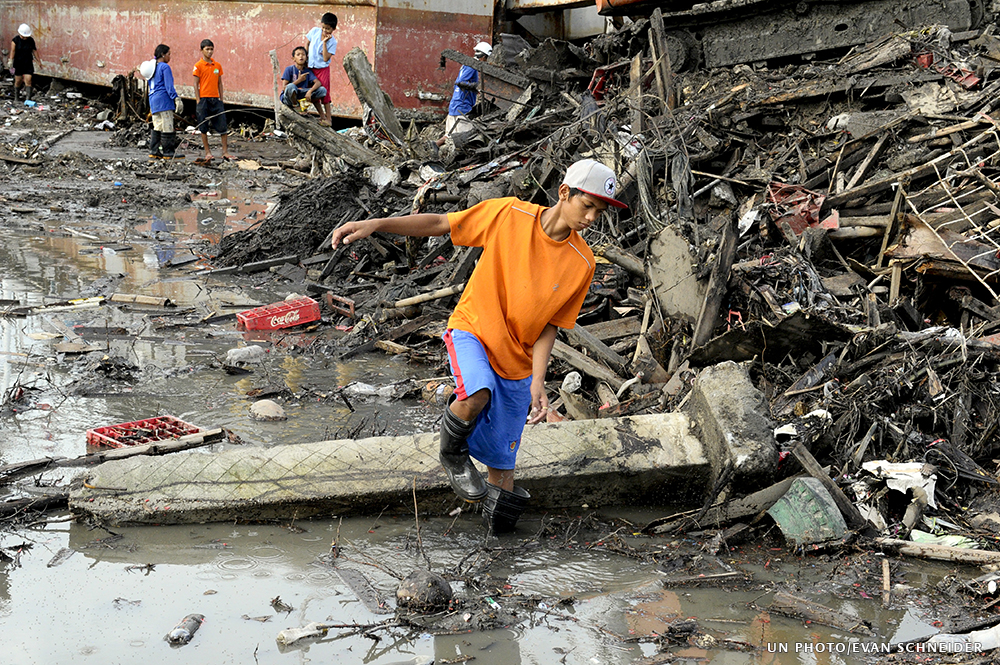POLICY PAPER
Dr. Mary Antonette Beroya-Eitner
CIFAL Philippines Fellow
To flee or not to flee
This is a question that may soon confront many of us Filipinos as the impacts of climate change loom larger in our country. With the Earth warming rapidly, sea levels are rising and low-lying coastal regions are threatening to disappear into the ocean, deadly climate-related calamities are striking more frequently, and the environment and people’s life support base are degrading at an ever faster pace. In areas where the climatic situation becomes completely inhospitable, migration may be the only choice. But are we ready for a potentially massive exodus of people?

Climate change effects are in the here and now
Sea levels in the Philippines, particularly on the eastern side, are rising at 5-7mm per year – about twice the global average (Kahana et al. 2016). In Manila, even larger increases have been observed largely due to excessive groundwater extraction and land subsidence, i.e. the gradual sinking of an area of land (Rodolfo and Siringan 2006). In a country which has the second longest coastline in Asia and where all major cities and majority of the population (60%) live on the coast (de Souza 2004, USAID 2017), rising sea levels are indeed cause for grave concern. High sea levels cause floods brought by storm surges and cause high tides to reach further into land. This results not only in greater loss and damage, but also in shoreline erosion plus salt-contamination of soil and groundwater. Ultimately, the rise of sea levels may cause the complete submergence of low-lying regions and islands, as what happened to some Pacific islands, according to a recent Australian study.
Using aerial photographs and satellite images, along with historical insights from local knowledge, Albert et al. (2016) identified five islands belonging to the Solomon Islands which had been totally eroded away between 1947 and 2014. A further six islands have undergone widespread shoreline recession, with island area declining by 20% to 62% over the same period. Shoreline recession at two sites destroyed communities that have existed since 1935, resulting in community relocations. This study scientifically confirms that the dramatic impacts of climate change on coastlines are not just imagined possibilities. They are real and they are happening. And if they are happening in other areas, they could be happening in the Philippines as well.
Equally alarming is the increased number and severity of extreme weather events in the Philippines. Geographically located along the typhoon belt in the Pacific, the country is naturally exposed to extreme weather hazards. But in the last decades, these events have apparently become even more frequent and more deadly. Of the 10 deadliest typhoons that hit the country between 1947 and 2014, five occurred between 2006 and 2016 (The Climate Reality Project 2016). In 2013, the Philippines ranked first among countries most affected by extreme weather events, owing mainly to Typhoon Haiyan, which was the strongest tropical cyclone to hit land on record (Kreft et al. 2014). While extreme events become deadly due to a host of socio-economic and political reasons, recent studies show that climate change plays a role in making these events more likely and more severe (Pidcock and Pearce 2017).
Climate change is also manifesting itself in the increased number of hot days and decreased number of cold nights from 1951 to 2010, which in turn are increasing the severity of droughts in the country. Droughts have been a constant threat in the Philippines. Between 1968 and 1998, 10 major drought events were recorded (de Guzman n.d.a), with the drought of 1997-1998 so severe that it affected about 70% of the country and cost a total of PHP 7.76 Billion in damage to agriculture (de Guzman n.d.b).
Meanwhile, all these – rising temperatures, rising sea levels, increased frequency and severity of typhoons and droughts – are causing the further degradation of our ecosystems, which to begin with, have already been in a sorry state due to over-exploitation and pollution. The people’s natural life support base is therefore fast eroding away.
Migration as an adaptation strategy
It is clear from the foregoing that, as climate change continues to advance, people’s lives and livelihoods will become more and more affected and some places may be rendered unlivable. The significance of climate change as a push factor for flight and migration is therefore expected to increase in the future.
Migration has been a common response to climate variability and change in the past. In the Philippines, a recent study by Bohra-Mishra et al. (2016) found that a rise in temperature and to some extent, increased typhoon activity, increase inter-provincial migration. Consistent with the fact that a large proportion of the country’s population is employed in the agricultural sector, out-migration is found to be higher in provinces that are more agriculturally dependent and have a larger share of rural population. This is due to the negative effect of the said climate variables on agricultural productivity.
Most climate-related migration, however, is only a temporary or seasonal adaptation-strategy in response to negative climatic and economic changes. For example, sudden disasters often drive a large number of people to short-term flight, many of whom will return to their homes as soon as possible and become involved in reconstruction (Bedarff and Jacobeit 2017). Furthermore, most migration has been taking place within national borders, and empirical evidence show that most people in the developing world would likely respond to further climatic changes by migrating internally (Bedarff and Jacobeit 2017; Waldinger and Fankhauser 2015). Nonetheless, whatever form such movement may take – temporary or permanent, internally or abroad – migration is generally seen as an important step to adapting to future climate-related calamities.
Planned, proactive migration is necessary
As Waldinger and Fankhauser (2015) have pointed out, migration, when not properly managed, could have high economic, social and psychological costs. Thus, policy intervention is necessary to reduce potential negative impacts both in source and destination regions.
The decision to migrate is multi-faceted, and people migrate either by choice, necessity or coercion. But even when the conditions are such that migration is already a necessity (such as during a disaster), it has been repeatedly observed not only in the Philippines, but in many countries as well, that many people still refuse to evacuate their homes. The reasons are varied: the need to protect their property; hesitance to leave their cultural roots behind; ignorance of the impending danger; uncertainty over the conditions in the region of destination; lack of resources to finance migration, among others. As dislocation can really have painful and unpleasant effects, policies should be aimed at strengthening the resilience of people and communities in vulnerable areas to prevent undesired migration, while enabling desired ones. In this case, “managed retreat” may be taken only as a last resort if conditions become completely inhospitable.

Policies should also be aimed at providing better support to vulnerable population groups, particularly the poor. Usually living in risky areas, poor people are the most vulnerable to the effects of climate change, yet they usually have no resources to mitigate these effects or to adapt to them, as through migration. Ironically, these people are the ones who contribute the least to greenhouse gas emissions. Providing them with substantial support is, therefore, a step towards addressing climate justice (Bedarff and Jacobeit 2017).
Outlined below are some policy items to enable effective migration choices and good management of the socio-economic effects of migration. They are based mainly on policy recommendations of Waldinger and Fankhauser (2015) for semi-arid economies, but which are also applicable to the Philippines:
- Provision of clear and sufficient information about the costs and benefits of migration, along with information about alternative adaptation options
- Provision of credit system to finance migration costs
- Improvement of security of land tenure to reduce migration disincentives that stem from fear of expropriation, and to enable re-establishment of shelter and livelihood on people’s return to their place of origin
- Provision of safeguards against distress migration, which can force people to choose sub-optimal migration strategies
- Provision of support to the areas affected by outward migration by providing links between migrants and their region of origin
- Expansion of the absorptive capacity of the destination region, in particular in terms of labor markets and public services
- Direction of migrants away from environmentally vulnerable areas in the destination region
Ultimately, it is only when migration is carefully planned and managed that it can be an effective response to the threats of climate change.
References
Albert, S., Leon, J.X., Grinham, A.R., Church, J.A., Gibbes, B.R. and Woodroffe, C.D., 2016. Interactions between sea-level rise and wave exposure on reef island dynamics in the Solomon Islands, Environ. Res. Lett. 11, 054011, doi:10.1088/1748-9326/11/5/054011
Bedarff, H. and Jakobeit, C., 2017. Climate Change, Migration and Displacement: The undersestimated disaster. A study commissioned by Greenpeace Germany. Retrieved from https://www.climate-diplomacy.org/publications/climate-change-migration-and-displacement-underestimated-disaster
Bohra-Mishra, P., Oppenheimer, M., Cai, R., Feng, S. and Licker, R. 2016. Climate variability and migration in the Philippines, Popul Environ, doi: 10.1007/s11111-016-0263-x
De Guzman, R.G., n.d.a. Impacts of drought in the Philippines. Retrieved from http://www.wamis.org/agm/meetings/etdret09/WOS2-de%20Guzman.pdf
De Guzman, R.G., n.d.b. Status of drought monitoring nad preparedness in the Philippines. Retrieved from http://www.wamis.org/agm/meetings/etdret09/ETDRET_Guzman.pdf
De Souza, R.M., 2004. Harmonizing population and coastal resources in the Philippines, World Watch Magazine, 17, 5. Retrieved from http://www.worldwatch.org/node/558
Kahana, R., Abdon, R., Daron, J. and Scannell, C., 2016. Projections of mean sea level change for the Philippines. Retrieved from http://www.precisrcm.com/DFID_Philippines_Reporting/Philippines_Sea_Level_Report_Oct_2016.pdf
Kreft, S., Eckstein, D., Junghans, L, Kerestan, C. and Hagen, U., 2015. Global Climate Risk Index 2015: Who suffers most from extreme waether events? Waether –related loss events in 2013 and 1994 to 2013. Briefing Paper, German Watch. Retieved from https://germanwatch.org/de/download/10333.pdf
Pidcock, R. and Pearce, R. (2017, July 6). Mapped: How climate change affects extreme weather around the world. Retrieved from https://www.carbonbrief.org/mapped-how-climate-change-affects-extreme-weather-around-the-world
Rodolfo, K.S. and Siringan, F.P., 2006. Global sea-level rise is recognised, but flooding from anthropogenic land subsidence is ignored around northern Manila Bay, Philippines, Disasters, 30, 1, 118−139.
The Climate Reality Project (2016, January 19). How is climate change affecting the Philippines. Retrieved from https://www.climaterealityproject.org/blog/how-climate-change-affecting-philippines
United States Agency for International Development (USAID), 2017. Climate change risk profile: Philippines, Climatelinks. Retrieved from https://www.climatelinks.org/resources/climate-change-risk-profile-philippines
Waldinger, M. and Fankhauser, S., 2015. Climate change and migration in developing countries: evidence and implications for PRISE countries, Policy paper, ESRC Centre for Climate Change Economics and Policy and Grantham Research Institute on Climate Change and the Environment. Retrieved from http://eprints.lse.ac.uk/64526/1/Climate-change-and-migration-in-developing-countries_final.pdf.
————
Acknowledgment
The author wishes to thank Ms. Victoria Villar-Demmer and Ms. Andrea Anolin for proofreading the article.
About the Author
Dr. Mary Antonette Beroya-Eitner is a consultant in ecosystem services management, hazard and vulnerability assessment, disaster risk reduction, climate change adaptation and urban resilience. She is the founding president of EarthThink. Dr. Beroya-Eitner is also currently a subject matter expert at Earthquake Megacities Initiatives (EMI) and a consultant at the Centre International de Formation des Autorités et Leaders (CIFAL-Philippines) under the United Nations Institute for Training and Research (UNITAR). Additionally, she serves as an Editorial Board Member of the Gravitazz Quarterly Publication Series on “African Perspective on Disaster Risk Reduction hosted by the Gravitazz Institute for Disaster Reduction and Emergency Management in Johannesburg, South Africa.
Dr. Beroya-Eitner completed bachelor and master degrees in Geology from the University of the Philippines, and a PhD degree in Engineering Geology from the University of Hong Kong. She has a second master degree in Global Change Ecology under the Elite International Masters Study Program of the University of Bayreuth, Germany. More recently, she was a postdoctoral research fellow at the United Nations University-Institute for the Advanced Study of Sustainability (UNU-IAS) and Tokyo University.

![[RIGHT]unitar_logo](https://cifal.up.edu.ph/wp-content/uploads/2024/01/RIGHTunitar_logo.png)